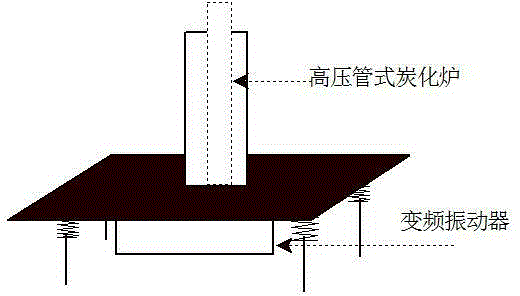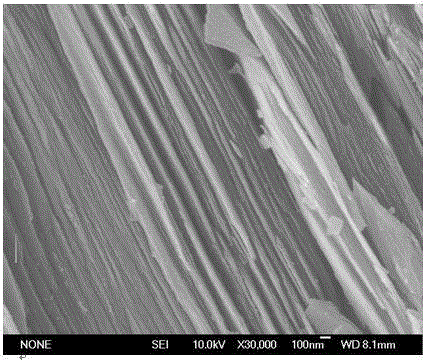Preparation method of nanometer thin-layer structural carbon material
A technology of carbon materials and thin layers, applied in the direction of nanotechnology, nanotechnology, nanotechnology for materials and surface science, etc., can solve the problems of high cost and low yield
- Summary
- Abstract
- Description
- Claims
- Application Information
AI Technical Summary
Problems solved by technology
Method used
Image
Examples
Embodiment 1
[0029] Take 50g of refined asphalt into a three-necked flask, add 1.25g of glycerin triacetate and 30ml of quinoline, reflux at 230°C under normal pressure for 3 hours, then raise the temperature to 300°C, and remove quinoline by vacuum distillation to obtain the modified coal tar pitch; then put the modified coal tar pitch into the attached figure 1 In the shown tube furnace with mechanical vibrating device, nitrogen is used to remove the air in the tube furnace to make the pressure in the furnace reach 300KPa, and then the tube furnace is heated at a heating rate of 5°C / min. When the temperature rises to 400°C, the vibration generator is turned on at a frequency of 10 Hz, and the vibrator is turned off after 1 h. Continue to heat the tube furnace at a heating rate of 5°C / min to 500°C, keep it for 4 hours and stop heating, and after cooling, the carbon material intermediate is obtained, and then the obtained carbon material intermediate is calcined at a high temperature of 1...
Embodiment 2
[0031] Put 50g of refined asphalt into a three-necked flask, add 3.5g of glycerin triacetate and 30ml of quinoline, reflux at 230°C under normal pressure for 3.5h, then heat up to 300°C and remove quinoline by vacuum distillation to obtain Modified coal tar pitch; then put the modified coal tar pitch into the attached figure 1 In the shown tube furnace with mechanical vibration device, use nitrogen to remove the air in the tube furnace and make the pressure in the furnace reach 600KPa, then heat the tube furnace at a heating rate of 5°C / min, when the temperature reaches 430°C , turn on the vibrator, the vibration frequency is 20Hz, and turn off the vibrator after 2h; continue to heat the tube furnace at a heating rate of 5°C / min to 530°C, stop heating after 6h, and cool to obtain a carbon material intermediate; finally The obtained carbon material intermediate was calcined at a high temperature of 1500°C for 2.5 hours in a nitrogen atmosphere to obtain 16 g of nano-thin-layer...
Embodiment 3
[0033] Put 50g of refined asphalt into a three-necked flask, add 5g of glycerin triacetate and 30ml of quinoline, reflux at 230°C under normal pressure for 5h, then heat up to 300°C and remove quinoline by vacuum distillation to obtain the modified coal tar pitch; then put the modified coal tar pitch into the attached figure 1 In the shown tube furnace with mechanical vibration device, use nitrogen to remove the air in the tube furnace and make the pressure in the furnace reach 1MPa, then heat the tube furnace at a heating rate of 12°C / min, when the temperature reaches 450°C , turn on the vibrator with a vibration frequency of 30 Hz, and turn off the vibrator after 3 hours; continue to heat the tube furnace at a heating rate of 5 °C / min to 550 °C, stop heating after heating for 6 hours, and cool to obtain a carbon material intermediate; The obtained carbon material intermediate was calcined at a high temperature of 1500°C for 5 hours in a nitrogen atmosphere to obtain 15 g of...
PUM
 Login to View More
Login to View More Abstract
Description
Claims
Application Information
 Login to View More
Login to View More - R&D
- Intellectual Property
- Life Sciences
- Materials
- Tech Scout
- Unparalleled Data Quality
- Higher Quality Content
- 60% Fewer Hallucinations
Browse by: Latest US Patents, China's latest patents, Technical Efficacy Thesaurus, Application Domain, Technology Topic, Popular Technical Reports.
© 2025 PatSnap. All rights reserved.Legal|Privacy policy|Modern Slavery Act Transparency Statement|Sitemap|About US| Contact US: help@patsnap.com


